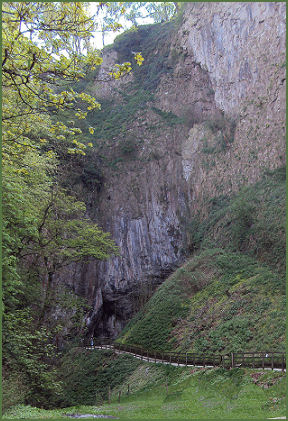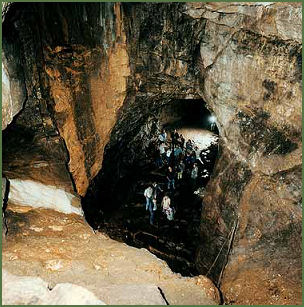Peak Cavern
O.S. Grid Ref:- SK 414865.01
 The Peak Cavern, also known as the Devil's Arse, is a large show cave in the attractive village of Castleton in the Peak District National Park.
The Peak Cavern, also known as the Devil's Arse, is a large show cave in the attractive village of Castleton in the Peak District National Park.
 Unlike the other show caves in the Castleton area, Peak Cavern is almost entirely natural, the only artificial part of the cave was blasted through to bypass a low tunnel which was only accessible by lying down on a boat. The cave is the largest in the Peak District, and its main entrance, measuring 102 feet wide and 60 feet in height, is the largest cave entrance in Britain.
Unlike the other show caves in the Castleton area, Peak Cavern is almost entirely natural, the only artificial part of the cave was blasted through to bypass a low tunnel which was only accessible by lying down on a boat. The cave is the largest in the Peak District, and its main entrance, measuring 102 feet wide and 60 feet in height, is the largest cave entrance in Britain.
The main entrance is situated down a steep gorge in Castleton village, that has 280 feet high vertical cliffs. The ruins of a Norman castle, Peveril Castle dominate the soaring cliffs at the head of the gorge.
A number of passages lead from the entrance chamber, which is known as "The Vestibule" and is an impressive 330 feet in length. Within the Vestibule visitors may see the remains of an ancient village where a whole community lived and worked making ropes for the local lead mines for more than 400 years.
Fibre-optic lighting systems highlight the splendour of the cavern chambers with their unusual flowstone and stalactite formations. From the Vestibule visitors enter the "Lumbago Walk", so named as traversing it requires most adults to stoop. The route continues through two main caverns, "The Great Cave" and "Roger Rain's House" with its perpetual cascade of water. Visitors to the cavern then pass through a passage, known as "Pluto's Dining Room" into the Devilís Cellar where the source of the river Styx can be heard. This is the furthest point currently open to the public, but the show cave once extended considerably further, down "The Devil's Staircase" to "The Halfway House" and then along an underground stream known as the "Inner Styx", via a series of bridges and under "Five Arches".
Up until 1915 the cave was home to some of Britain's last cave dwellers, who lived in houses built inside the cave mouth, and made a living from rope making, while the depths of the cave were known as a haven for bandits.
Guided tours, including traditional ropemaking demonstrations, last around an hour.
